 |
Mehrangarh Fort - A bird's eye view
|
"Let the new fort you build and the surrounding areas suffer by drought. Let it be impossible for any human or animal to live here!" such was the curse of the sage. The King begged the pardon of the sage, and asked him what penance would revert the effect of the curse. The sage proposed a very difficult penance - human sacrifice. Not only that, the person who sacrifices his life must do so willingly. The King was in a dilemma. However soon after this news spread across his kingdom, a soldier named "Rajaram Mehwal" presented himself before the king and conveyed his decision to sacrifice his life. The King accepted, when the foundation of the fort was laid, Rajaram Mehwal was buried beneath it. Thus goes the history of Mehrangarh Fort of Jodhpur. Mehrangarh Fort was built in the year 1459.
 |
| Fort Walls and the Palaces |
The first sight that welcomes you when visiting Mehrangarh fort is the rough high walls and the balconies of the palaces above it. I was quite curious about the position of the palaces. Usually in Rajasthan Forts, the palaces would be placed in the heart of the fort, secured by many levels of gates and walls. However the audio guide told me that these palaces are placed in such a vulnerable position to get some cool air during the unbearable summer season. Does the below picture seems similar? It is the same place featured in “The Dark Knight Rises” – the latest and best batman movie of all times! When Bruce Wayne comes up from the jail like a deep well, the background shown is the Mehrangarh Fort!
Architecture of Mehrangarh Fort
My visit to the Mehrangarh fort started at the first gate known as the "Jai Pol". In Rajasthan, the main entrances to the palaces and forts are known as Pols. Mehrangarh Fort has 7 gates in total at different levels. The gates of Mehrangarh fort are: Jai Pol, Fateh Pol, Loha Pol, Amruti Pol, Dodh Kangra Pol, Gopal Pol and Bheru Pol. Even though the Jai Pol is the entrance for visitors, this was not the main entrance to the fort in ancient days. Jai Pol is newer compared to the other parts of the Fort. It was built in 1810 by Maharaja Man Singh. Jai Pol was added to enhance the security after the Jaipur-Jodhpur was in 1809. Even though both the countries were ruled by brother clans, there were serious dispute between them. One of the reasons for the dispute was the Princess of Udaipur. Both the Kings in Jodhpur and Jaipur claimed that they have the right to marry the rich and beautiful princess of Udaipur!
 |
| Jai Pol in Mehrangarh Fort |
 |
| Paintings in Jaipol - Mehrangarh Fort |
Entering through the Jai Pol, I reached a small courtyard with
high surrounding walls. While visiting the Mehrangarh fort, never miss to see
the canon shot marks on the walls of this corridor, it was said to be made in
the 1809 Jaipur-Jodhpur war.
 |
| Canon Marks on the Mehrangarh Fort wall |
 |
| Shahid Bhure San Memorial - Mehrangarh Fort |
I was going at snail pace and the magnificent fort was standing in front me, challenging. It is quite exhaustive to walk uphill to the top of the fort and come back. For those who are not physically fit to do so, the fort has lift service. However it is much more fun to walk around! Mehrangarh fort is exemplary in terms of the facilities for visitors. There are good hotels, clean toilets and above all an excellent audio guide! On the way up the ramp, on the left side of the road, there is a very important historical inscription. It is a memorial of Raja Ram Mehwal who sacrificed his life for the fort.
 |
| Raja Ram Mehwal memorial in Mehrangarh Fort |
Also, next to the Raja Ram Mehwal memorial there is a platform named - Rao Jodha Ka Falsa . It marks the boundary of the Mehrangarh Fort, as initially decided by Rao Jodha. However the fort was extended well beyond this point by his successors.
 |
| Rao Jodha Ka Falsa - The boundary of Mehrangarh Fort |
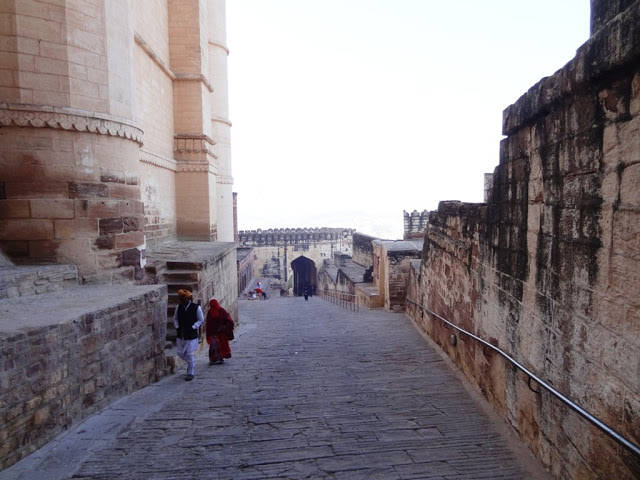 |
| Amriti Pol and the Ramp leading to the Loha Pol |
The ramp becomes quite steep and then there is a ninety degree bend in the walkway. Right in front of it, there stand the ferocious "Loha Pol". The steep ramp and the hair pin bend in the path are to prevent elephants of the attacking army to charge towards the Fort gates. The Loha pol is also equipped with sharp metal spears protruding from it. It is to wound the elephants who try to barge through the Loha pol. It is quite scary!
 |
| The ferocious Loha Pol of Mehrangarh Fort |
On the road leading from the Loha Pol, there is a very important monument which reminds us of a quite sad ritual Sati. For those who don’t know, Sati was a ritual practiced in ancient India. When a woman is widowed, she commits suicide by jumping into the funeral pyre of her husband. The women who committed Sati are considered as a Goddess thereafter. The Sati memorial in Mehrangarh Fort is a series of hand prints by those women who performed Sati ritual at Mehrangarh Fort. As each woman exit the Mehrangarh fort following her husband's funeral procession, she dips her hand in vermilion and makes a mark on the Fort wall. Later these hand prints are preserved as a mark to remember those women who either voluntarily or involuntarily sacrificed their lives. I spent a few quiet moments in front of the Sati memorial of Mehrangarh fort.
 |
| Mehrangarh Fort - The Sati memorial |
The next courtyard of Mehrangarh Fort is known as the "Shringar Chowk". It is the place where the coronation of the new king takes place. The coronation ceremony is known as "Raj Tilak". There is also a humble marble throne at the end of raised platform.
 |
| Mehrangarh Fort - The throne in Shringar Chowk |
During the coronation ceremony, the king-to-be-anointed would sit on this small throne. The last coronation ceremony in Mehrangarh Fort took place in 1953. It was the coronation ceremony of His Highness Maharaja Gajaraj Singh II.
 |
| Mehrangarh Fort - The platform in Shringar Chowk where Raj Tilak celebrated |
As I stood in the Shringar Chowk, I just looked around. We can see intricately carved red sand stone windows of the upper floors of Mehrangarh fort from Shringar Chowk.
 |
Mehrangarh Fort - Red sand stone windows with intricate carvings
By Pratibha Choudhary (Own work) [CC BY-SA 3.0], via Wikimedia Commons
|
There are 2 exhibition halls situated in the Shringar Chowk. One is the exhibition of the Royal Howdas. Howdah means the seat that is placed on top of an elephant when the royal men ride it. The Royal Howdah collection of Mehrangarh fort is quite extensive.
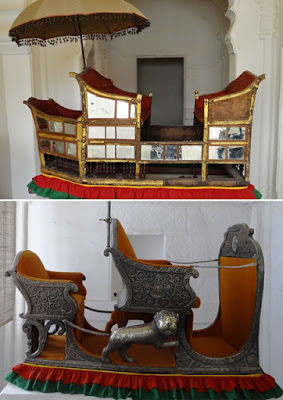 |
| Mehrangarh Fort - Royal Howdas |
They are made using silver, gold, silk and wood. The next exhibition is that of palanquins. It is also known as "Palki-Khana". The palanquin museum contains some real gems. One of them is the palanquin made with red and gold silk material.
 |
Mehrangarh Fort - Royal Palanquin
|
I climbed up to reach the next courtyard of Mehrangarh fort. It is known as the "Daulat Khana Chowk". "Daulat Khana" means treasury. Daulat Khana is indeed a treasury of rooms with incredible architecture and decorations. May be in ancient times it acted as a treasury also. Daulat Khana is a three storied building. The ground floor was used as the public audience hall of Raja Ajit Singh.
 |
Mehrangarh Fort - Daulat Khana Chowk
By Varun Shiv Kapur from New Delhi, India (Mehrangarh Fort) [CC BY 2.0], via Wikimedia Commons
|
The first floor is the palace rooms and the second floor is the open terrace. The ground floor of Daulat Khana is now converted into the archaeological museum of Mehrangarh fort. Many curious artifacts that belong to the royal family are on display here. However the central piece is a beautiful palanquin, which is not quite in the Rajput style. There is a curious history behind this palanquin. This actually belongs to Gujarat. In 1730s, Jodhpur king acted as the Gujarat governor under the British. This palanquin is brought from Gujarat during that time.
 |
| Mehrangarh Fort - Gujarati Palanquin |
There are many other items on display which has their own historical background. Another interesting piece is the ornament box made in pure ivory. Those who have seen the "Jodha-Akbar" movie, shot in the backdrop of Rajasthan will appreciate the variety and beauty of Rajasthani ornaments.
 |
| Mehrangarh Fort - ornament box in carved ivory |
There is Kundhan, Meenakari, Teva and much more beautiful types of Rajasthani ornaments. Another interesting artifact is the idol of the Goddess Gangur. Gangur is a form of Goddess Parvati.
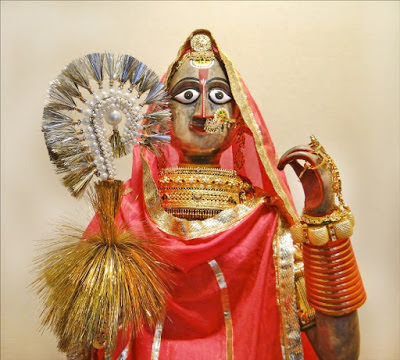 |
| Mehrangarh Fort - Goddess Gangur By Jean-Pierre Dalbéra from Paris, France [CC BY 2.0], via Wikimedia Commons |
 | |
|
 |
Mehrangarh Fort -The Sheesh Mahalin Day light
|
"Lustrous" is the only word that can explain the Sheesh Mahal of Mehrangarh fort. When light falls on one of the mirrors, it gets reflected numerous times and gives a glowing appearance to the room. It looks like the walls of Sheesh Mahal are on fire! Another striking and beautiful feature of the Sheesh Mahal is the mural painting on the walls. There are depiction of local folklore, Hindu gods and King's adventures.
 |
Mehrangarh Fort -The lustrous Sheesh Mahal
By SangeetaC (Own work) [CC BY-SA 3.0], via Wikimedia Commons
|
The next room I visited was no lesser than Sheesh Mahal in its beauty. This chamber is known as "Phool Mahal". "Phool Mahal" means the "palace of flowers". Phool Mahal of Mehrangarh Fort was built by Raja Abhay Singh - Son of Raja Ajit Singh.
 |
Mehrangarh Fort - Interiors of Royal chamber Phool Mahal
By Kiral (Own work) [CC BY-SA 3.0], via Wikimedia Commons
|
 | |
|
 |
Mehrangarh Fort - Interiors of Royal chamber Phool Mahal
By Hector Garcia from Barcelona (PalaceUploaded by Ekabhishek) [CC BY-SA 2.0], via Wikimedia Commons
|
Next, I proceeded to "Takat Vilas" one of the most luxurious palace chambers in Mehrangarh Fort. The room is decorated with gold, white and blue stones and mirrors everywhere. Starting from the blue and white floor tiles, the wooden roofing with heavy wood, the ornate walls - Takat Vilas is a reflection of its creator.
 |
| Mehrangarh Fort - Highly decorated Takat Vilas |
"Takat Vilas" of Mehrangarh fort was built by Raja Takat Singh who ruled Jodhpur between 1843 and 1872. He was known as a romantic person. Beauty had always enchanted Takat Singh. He might have felt that the most beautiful room of Mehrangarh fort should be Takat Vilas. One curious thing in Takat Vilas is the multicolored Christmas balls hanging from the roof. Mehrangarh audio guide told me that it was a gift from the British. Rajput kings always had a good diplomatic relationship with the British!
 |
| Mehrangarh Fort - Roof of Takat Vilas |
There is a spacious terrace outside the Takat Vilas. This is the best place in the Mehrangarh Fort to get a view of the Blue City Jodhpur. Jodhpur is called "The Blue City" thanks to this iconic view of roofs painted in blue color.
 | |
|
This city region is known as "Brahmapuri" - in olden days majority of the Brahmin community of Jodhpur resided in Brahmapuri. The roofs of the houses are painted in blue to in fact reduce the heat seeping into the house during hot summer days in Jodhpur. It is a photo point in Mehrangarh Fort. There is always a crowd waiting to get a perfect shot with the Blue City Jodhpur in background in its glory!
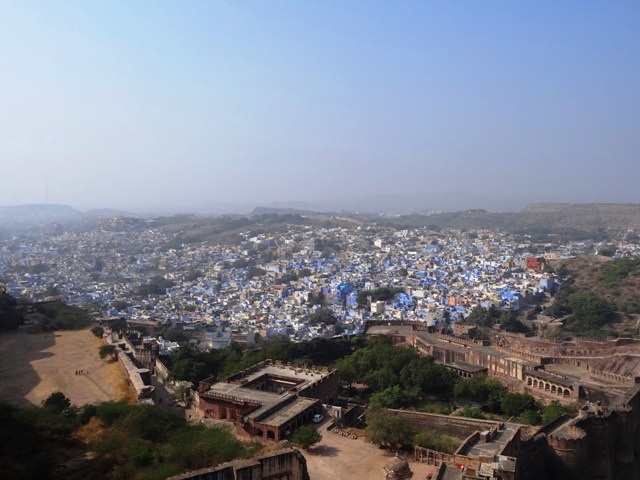 | |
|
We entered into the next part of the Mehrangarh Fort. It is known as "Zenana". The word Zenana means the women quarters. The royal women followed the ritual of Purdah. Purdah is a tradition where a woman covers her face from public. Only her husband, sons and women maids can see her face. There was a clear distinction in Mehrangarh fort between the men dominated areas - known as Mardana - and women dominated area known as Zenana. No man was allowed to cross the barriers without the consent of King.
 |
| Mehrangarh Fort - Jhanki Mahal - cradle museum |
The next royal quarters I entered is named the Jhanki Mahal . "Jhanki" means glimpse. The women folk of the palace used to stand in this room and looked at the proceedings and meetings going on in Daulat Khana Chowk. The Janki Mahal in Mehrangarh Fort is so named because it enabled the royal women to get a glimpse of the day to day life in the court.
Now, Janki Mahal in Mehrangarh fort is converted into a museum of cribs. One of the striking features of Jhanki Mahal is the beautifully painted blue colour roof.
The next royal quarters of Mehrangarh fort is known as the "Moti Mahal" - Moti Mahal means the palace of pearls. Moti Mahal is quite simple but beautiful with its white walls and stained colour window glasses. Moti Mahal of Mehrangarh Fort was built by Raja Ajith Singh and later modified by Raja Takat Singh.
 |
Mehrangarh Fort -Moti Mahal
|
From Moti Maha we enter into another courtyard of Mehrangarh Fort, know and the Zenana Dheodi Chowk (check spelling). This is a courtyard reserved entirely for women. The audio guide of Mehrangarh for has a nice voice footage of an old queen recollecting the lively and beautiful days she spent in Zenana Dheodi Chowk with her girlfriends and maids. It’s quite touching.
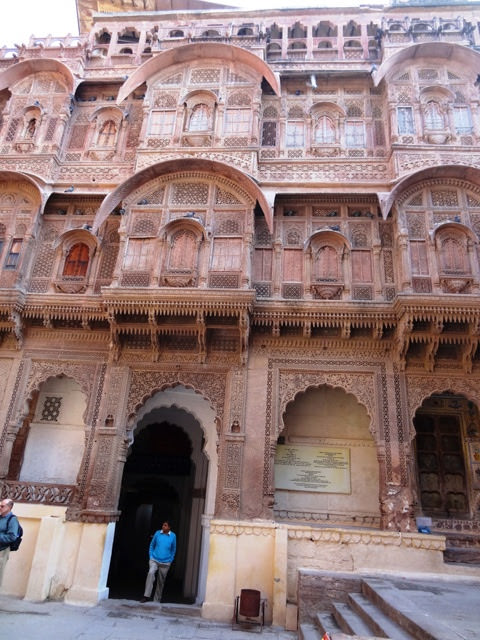 |
| Mehrangarh Fort - Zenana Dheodi Chowk |
The audio guide for Mehrangarh fort ends at this point. After returning the audio guide and collecting the identity cards, I moved upper towards the fort walls. There is a gun terrace, where many cannons of different age and size are on display. From this point one can see the Sardar Market and Clock Tower in Jodhpur city. From Mehrangarh fort, Umaid Bhavan Palace is also visible. Umaid Bhavan palace was later built by the Jodhpir Kings to match the British style mansion, were the Victorian architecture is evident.
 |
| Mehrangarh Fort - gun terrace |
From the Gun Terrace of Mehrangarh fort, one can also see the temple of Chamunta Mathaji. Chamunta Mathaji was the family diety of the Rajput Kings and the favorite Goddess of Rao Jodha. An accident occurred in Chamuta Mathaji temple in 2008. 249 people died in a stampede occurred in the temple during the Navarathri festivals. Even more people were seriously injured in this accident of Mehrangarh fort.
 |
| Mehrangarh Fort - temple of Chamunta Mathaji |
We started walking down and had our food from a small restaurant named Palki. Mehrangarh fort has many restaurants serving variety of food options to eat at any budget. There is Palki, Caffe Mehran, Chokelao Mahal. Candle light dinner at the Mehrangarh fort in the Chokelao Mahal restaurant is quite a great experience. However, it is quite expensive too. ( (https://yummraj.com/2015/09/23/chokelao-mahal-restaurant-mehrangarh-fort-jodhpur/) see details.
 |
| Mehrangarh Fort -Chokelao Mahal |
Chokelao Mahal restaurant in Mehrangarh Fort is actually a small palace converted. Chokelao Mahal was built by Raja Takat Singh. He had number concubines outside of the Rajput caste. This created tension between his legitimate wives and concubines. The legitimate wives of Raja were not ready to co-exist with the concubines in Zenana. Hence Raja Takat Singh made a new palace for the non-Rajput concubines. The position of Chokelao Mahal is quite queer. Usually the dwelling place of women in the Fort usually is buried deep inside the Fort walls. It’s for their safety and seclusion. However, Chokelao Mahal stands outside the Fort walls in a quite exposed position.
Another attraction at Mehrangarh is for adventure lovers. The Zip line tour of Mehrangarh Fort is arranged by Flying Fox adventure and the cost for adult is 1899.00. See here for more details: (http://flyingfox.asia/destinations/index/Jodhpur)
With Chokelao Mahal, I concluded my visit to Mehrangarh Fort and ran through the 500 years history of the Mehrangarh Fort in less than 3 hours.
*For Indian citizen, it may vary for foreign visitor. As on 25st January 2015.

Best information I have found about this fort. Thank you for labeling the photos and all the info on the different palaces. I came home with loads of photos but wasn't sure what was what until I read your blog. Also wish I'd read it before my visit as our guide didn't show us some important features, but then I knew our trip was very rushed.
ReplyDeleteWell done, great site!
An outstanding share! I've just forwarded this onto a friend who was conducting a little homework on this. And he in fact ordered me dinner simply because I discovered it for him... lol. So let me reword this.... Thanks for the meal!! But yeah, thanks for spending time to discuss this subject here on your site. msn hotmail sign in
ReplyDeletePost a Comment